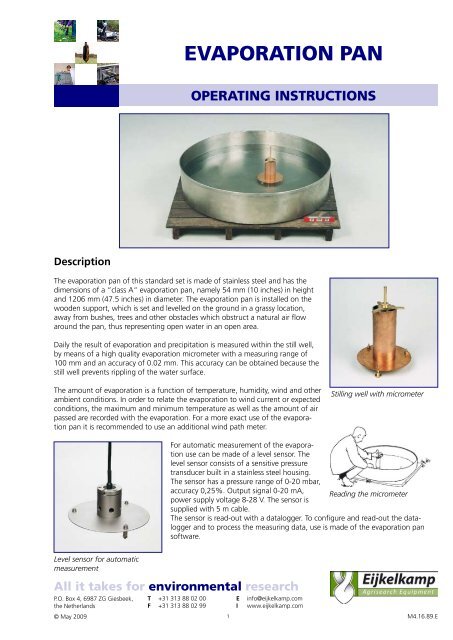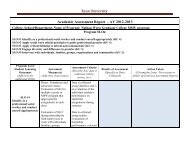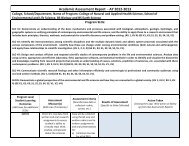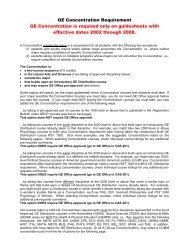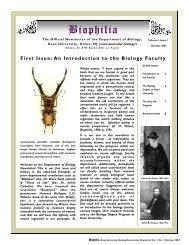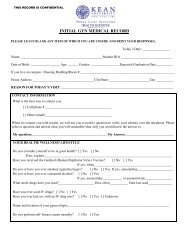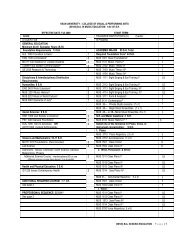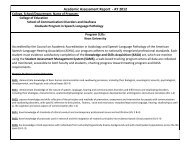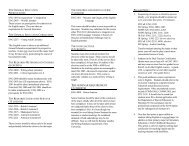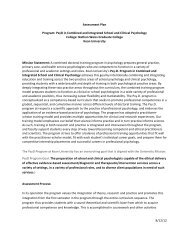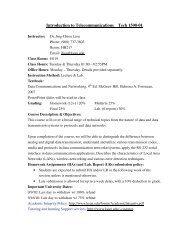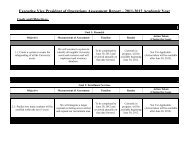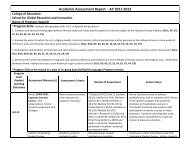Evaporation pan - Eijkelkamp Agrisearch Equipment
Evaporation pan - Eijkelkamp Agrisearch Equipment
Evaporation pan - Eijkelkamp Agrisearch Equipment
You also want an ePaper? Increase the reach of your titles
YUMPU automatically turns print PDFs into web optimized ePapers that Google loves.
<strong>Evaporation</strong> Pan<br />
operating instructions<br />
Description<br />
The evaporation <strong>pan</strong> of this standard set is made of stainless steel and has the<br />
dimensions of a “class A“ evaporation <strong>pan</strong>, namely 54 mm (10 inches) in height<br />
and 1206 mm (47.5 inches) in diameter. The evaporation <strong>pan</strong> is installed on the<br />
wooden support, which is set and levelled on the ground in a grassy location,<br />
away from bushes, trees and other obstacles which obstruct a natural air flow<br />
around the <strong>pan</strong>, thus representing open water in an open area.<br />
Daily the result of evaporation and precipitation is measured within the still well,<br />
by means of a high quality evaporation micrometer with a measuring range of<br />
100 mm and an accuracy of 0.02 mm. This accuracy can be obtained because the<br />
still well prevents rippling of the water surface.<br />
The amount of evaporation is a function of temperature, humidity, wind and other<br />
ambient conditions. In order to relate the evaporation to wind current or expected<br />
conditions, the maximum and minimum temperature as well as the amount of air<br />
passed are recorded with the evaporation. For a more exact use of the evaporation<br />
<strong>pan</strong> it is recommended to use an additional wind path meter.<br />
Stilling well with micrometer<br />
For automatic measurement of the evaporation<br />
use can be made of a level sensor. The<br />
level sensor consists of a sensitive pressure<br />
transducer built in a stainless steel housing.<br />
The sensor has a pressure range of 0-20 mbar,<br />
accuracy 0,25%. Output signal 0-20 mA,<br />
Reading the micrometer<br />
power supply voltage 8-28 V. The sensor is<br />
supplied with 5 m cable.<br />
The sensor is read-out with a datalogger. To configure and read-out the datalogger<br />
and to process the measuring data, use is made of the evaporation <strong>pan</strong><br />
software.<br />
Level sensor for automatic<br />
measurement<br />
All it takes for environmental research<br />
P.O. Box 4, 6987 ZG Giesbeek,<br />
the Netherlands<br />
© May 2009<br />
T +31 313 88 02 00<br />
F +31 313 88 02 99<br />
<br />
E<br />
I<br />
info@eijkelkamp.com<br />
www.eijkelkamp.com<br />
M4.16.89.E
Measuring principle<br />
An evaporation <strong>pan</strong> provides a measurement of the combined effect of temperature, humidity, windspeed and<br />
sunshine on the reference crop evapotranspiration ET o<br />
.<br />
The principle of the evaporation <strong>pan</strong> is the following:<br />
the <strong>pan</strong> is installed in the field<br />
the <strong>pan</strong> is filled with a known quantity of water (the surface area of the <strong>pan</strong> is known and the water depth is<br />
measured)<br />
the water is allowed to evaporate during a certain period of time (usually 24 hours). For example, each morning<br />
at 7 o’clock a measurement is taken. The rainfall, if any, is measured simultaneously<br />
after 24 hours, the remaining quantity of water (i.e. water depth) is measured<br />
the amount of evaporation per time unit (the difference between the two measured water depths) is calculated;<br />
this is the <strong>pan</strong> evaporation: E <strong>pan</strong> (in mm/24 hours)<br />
the E <strong>pan</strong> is multiplied by a <strong>pan</strong> coefficient, K <strong>pan</strong>, to obtain the ETo.<br />
Formula: ET o<br />
= K <strong>pan</strong> × E <strong>pan</strong><br />
with:<br />
ET o<br />
: reference crop evapotranspiration<br />
K <strong>pan</strong> : <strong>pan</strong> coefficient<br />
E <strong>pan</strong> : <strong>pan</strong> evaporation<br />
If the water depth in the <strong>pan</strong> drops too much (due to lack of rain), water is added and the water depth is measured<br />
before and after the water is added. If the water level rises too much (due to rain) water is taken out of the<br />
<strong>pan</strong> and the water depths before and after are measured.<br />
Determination of K <strong>pan</strong><br />
When using the evaporation <strong>pan</strong> to estimate the ET o<br />
, in fact, a comparison is made between the evaporation from<br />
the water surface in the <strong>pan</strong> and the evapotranspiration of the standard grass. Of course the water in the <strong>pan</strong> and<br />
the grass do not react in exactly the same way to the climate. Therefore a special coefficient is used (K <strong>pan</strong>) to<br />
relate one to the other.<br />
The <strong>pan</strong> coefficient, K <strong>pan</strong>, depends on:<br />
the type of <strong>pan</strong> used<br />
the <strong>pan</strong> environment: if the <strong>pan</strong> is placed in a fallow or cropped area<br />
the climate: the humidity and windspeed
For the Class A evaporation <strong>pan</strong>, the K <strong>pan</strong> varies between 0.35 and 0.85. Average K <strong>pan</strong> = 0.70.<br />
The K <strong>pan</strong> is high if:<br />
the <strong>pan</strong> is placed in a fallow area<br />
the humidity is high (i.e. humid)<br />
the windspeed is low<br />
The K <strong>pan</strong> is low if:<br />
the <strong>pan</strong> is placed in a cropped area<br />
the humidity is low (i.e. dry)<br />
the windspeed is high<br />
If the <strong>pan</strong> factor is not known the average value could be used. If more accuracy is required, the <strong>pan</strong> factors can<br />
be taken grom the table below (for class A <strong>pan</strong> only). Table: Pan coefficients (Kp) for Class A <strong>pan</strong> for different <strong>pan</strong><br />
siting and environment and different levels of mean relative humidity and wind speed (FAO Irrigation and Drainage<br />
Paper No. 24)<br />
Example:<br />
1) Type of <strong>pan</strong>: Class A evaporation <strong>pan</strong><br />
Water depth in <strong>pan</strong> on day 1 = 150 mm<br />
Water depth in <strong>pan</strong> on day 2 = 144 mm (after 24 hours)<br />
Rainfall (during 24 hours) = 0 mm<br />
K <strong>pan</strong> = 0.75<br />
Formula: ET o<br />
= K <strong>pan</strong> × E <strong>pan</strong><br />
Calculation: E <strong>pan</strong> = 150 - 144 = 6 mm/day<br />
ET o<br />
= 0.75 × 6 =4.5 mm/day<br />
For more information:<br />
www.fao.org<br />
Crop evapotranspiration - Guidelines for computing crop water requirements - Irrigation and drainage paper 56<br />
Nothing in this publication may be reproduced and/or made public by means of print, photocopy, microfilm or any other means without previous<br />
written permission from <strong>Eijkelkamp</strong> <strong>Agrisearch</strong> <strong>Equipment</strong>.<br />
Technical data can be amended without prior notification.<br />
<strong>Eijkelkamp</strong> <strong>Agrisearch</strong> <strong>Equipment</strong> is not responsible for (personal damage due to (improper) use of the product.<br />
<strong>Eijkelkamp</strong> <strong>Agrisearch</strong> <strong>Equipment</strong> is interested in your reactions and remarks about its products and operating instructions.


